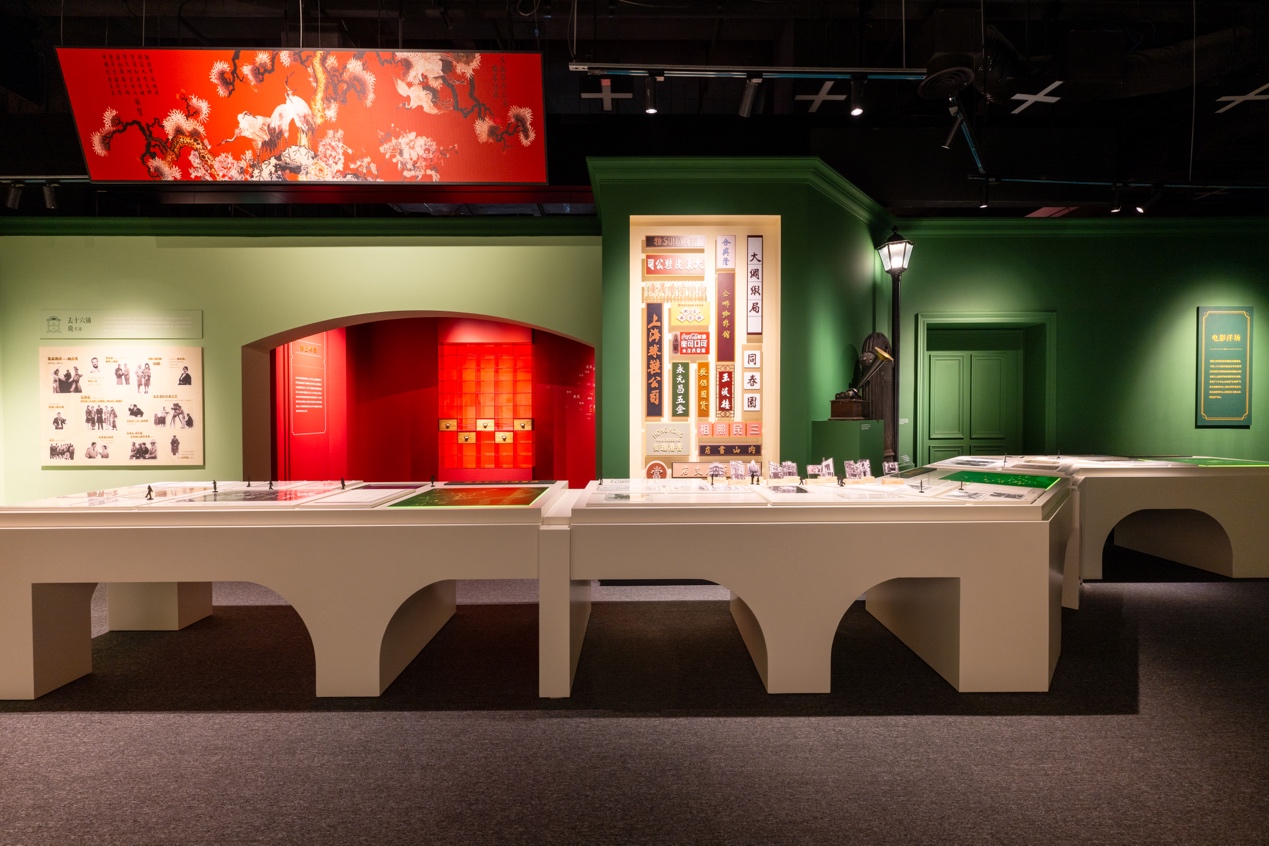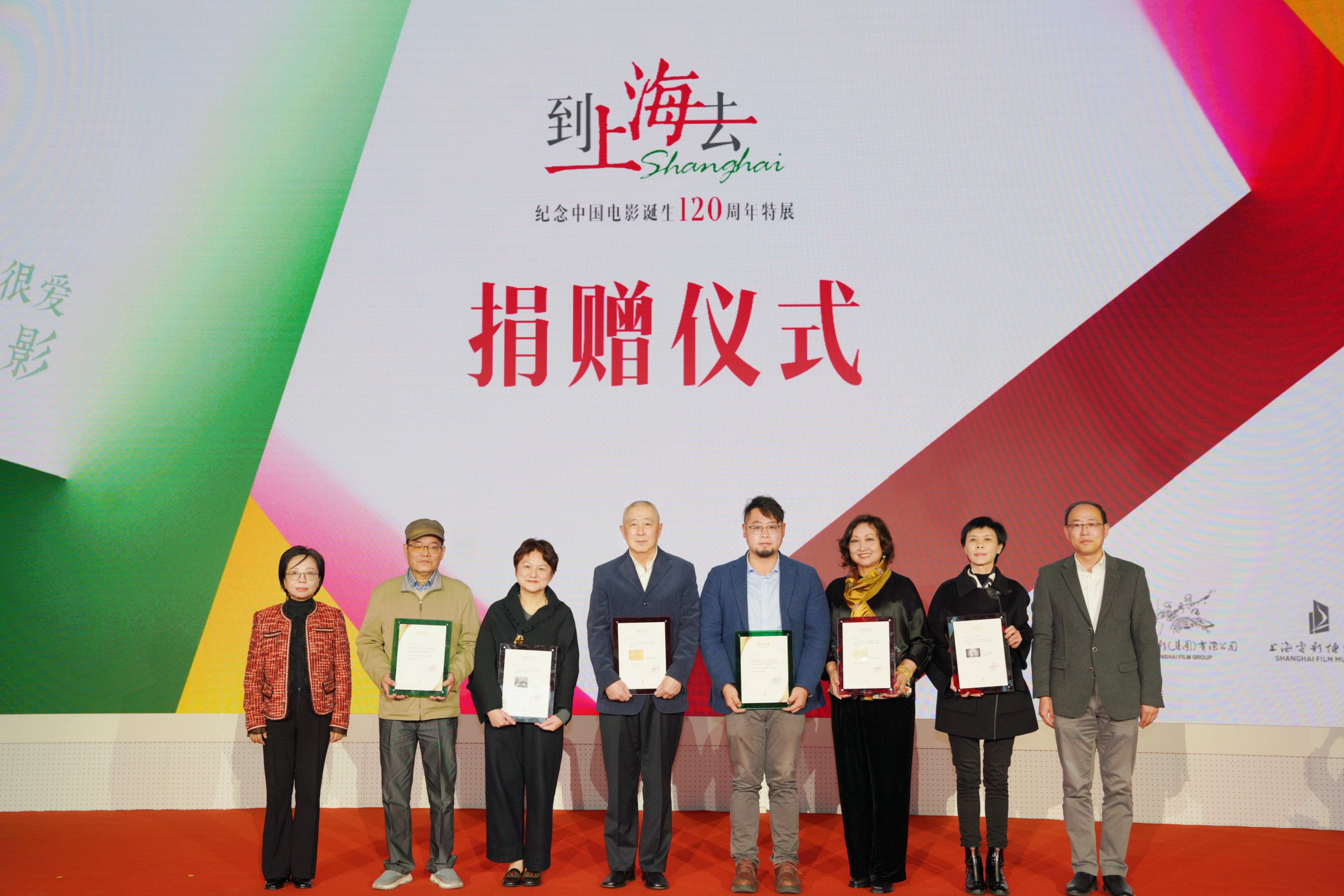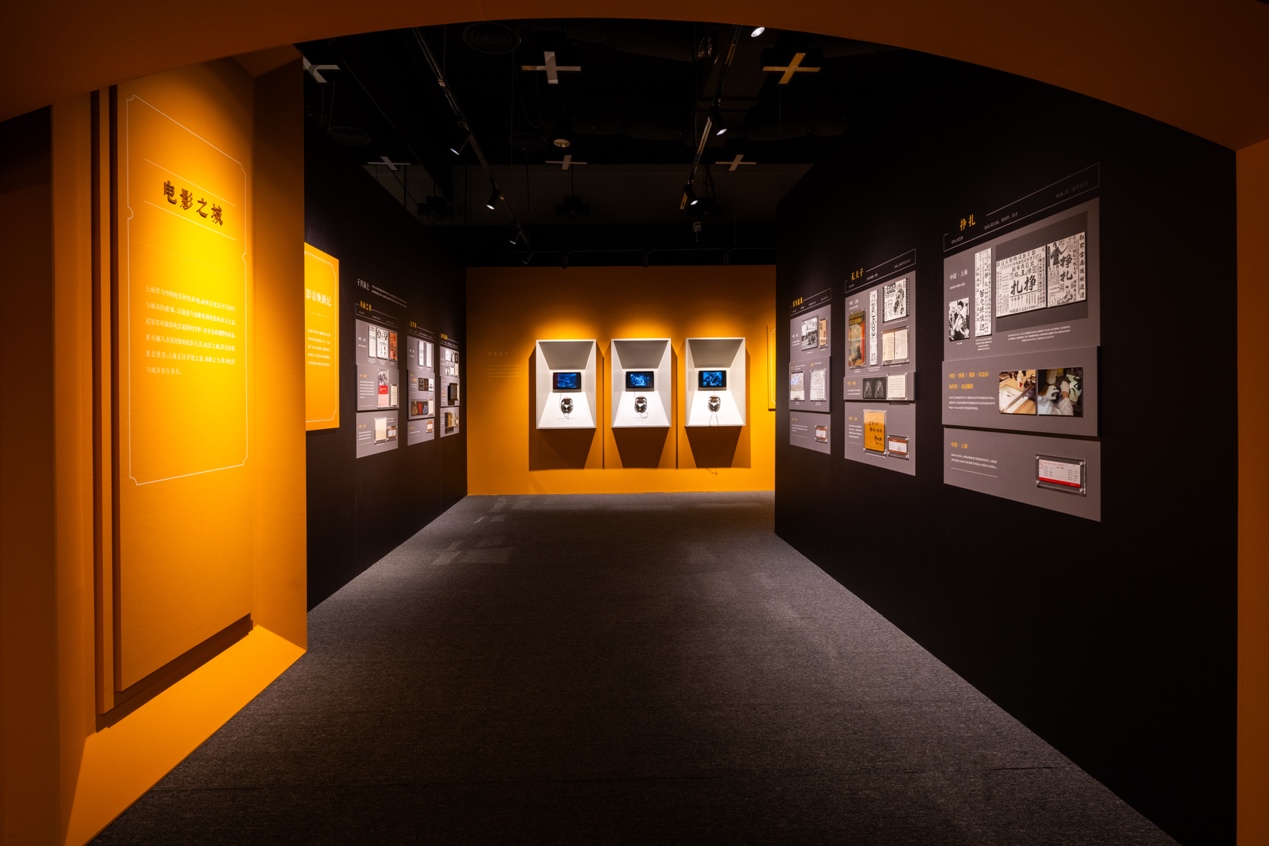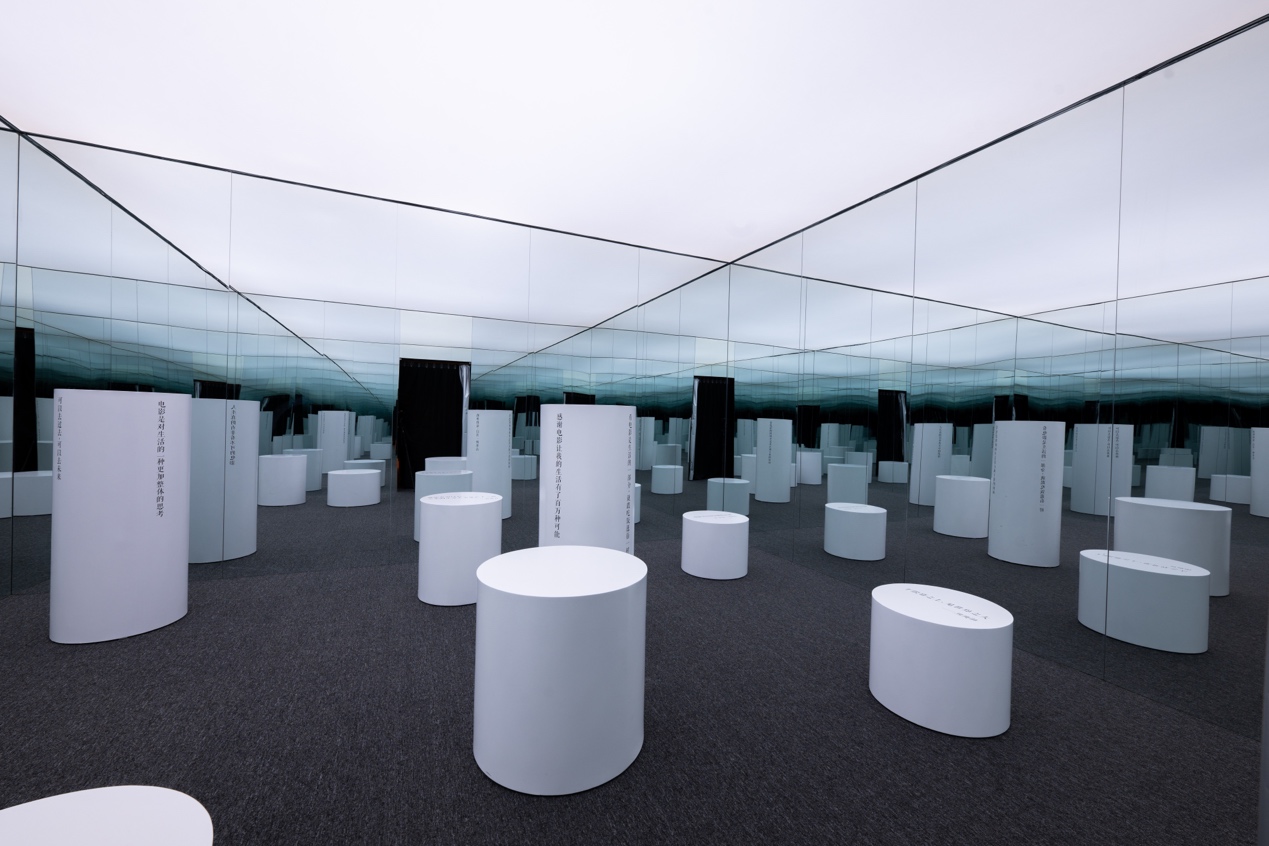
The newly opened "Go to Shanghai - A Special Exhibition Commemorating the 120th Anniversary of the Birth of Chinese Cinema" is the largest exhibition in terms of scale, materials, and investment since the Shanghai Film Museum opened. The exhibition features a 35mm "Lianhua Camera", a celebratory banner from the opening of Minxin Company in Shanghai nearly a century ago, a scene from the movie "The Butterfly Lovers" depicting the meeting at the pavilion, and a large amount of historical material from a famous film.
This exhibition, guided by the Shanghai Municipal Film Bureau and hosted by Shanghai Film Group, and organized by Shanghai Film Museum and Shanghai Film Archive, is one of the series of activities of Shanghai Film Group to commemorate the 120th anniversary of Chinese cinema. It vividly and comprehensively showcases the special charm of Shanghai as a "city of film" and the profound cinematic history of Shanghai Film Group.

Opening Ceremony
The exhibition will showcase 761 exhibits across three core exhibition areas, systematically presenting the development of Shanghai cinema, the creative trajectory of classic works, and the latest practices in building a "City of Film," organically complementing the permanent exhibitions of the Shanghai Film Museum. Nearly 80% of the exhibits, including a 120-second tribute video to "Dingjun Mountain," are making their debut. The exhibition also highlights several new academic research findings from the Shanghai Film Museum, showcasing how Shanghai has become a "three-center" for film commerce, film consumption, and film production.
Tracing the century-long connection between Shanghai and film
With the development of East-West trade at the end of the 19th century, Shanghai, with its unique geographical advantages and modern urban form, provided fertile ground for the establishment of film in China, and continued to develop into the birthplace of Chinese cinema and one of the most important film culture centers in Asia.

"A Choice Called Shanghai" Exhibition Area
The birthplace of Shanghai cinema and its rapid establishment as the "Hollywood of the East" is vividly presented in the first exhibition area of this exhibition, "A Choice Called Shanghai." This area is divided into three parts: "The Cinematic Bund" focuses on how Huangpu, Hongkou, and Xujiahui districts of Shanghai became the three major centers of film commerce, consumption, and production; "Western Cinema Spreads East" examines how film was introduced to Shanghai from the West, forming a unique landscape of cultural exchange and dissemination between China and the West; and "Breaking Dimensions Together" captures the moments when early Chinese and foreign filmmakers, represented by Charlie Chaplin and Anna May Wong, met in Shanghai. The section highlighting Shanghai as one of the three major centers of early cinema is a curatorial presentation by the Shanghai Film Museum of the latest academic findings.
The exhibition area features subheadings with distinctive Shanghai dialect, such as "The King of Comedy Comes to Play," "Miss Huang Strolls the Street," and "Going to Shiliupu to Do Business," which exude a strong Shanghai flavor and make the academic content lively and approachable. The exhibition also includes a nearly life-size replica of a celebratory banner presented by prominent Cantonese merchants when the Minxin Film Company opened in Shanghai in 1926. This approximately four-meter-long embroidered banner integrates auspicious motifs of "Jade Hall of Wealth and Prosperity" and "Pine and Crane Longevity," symbolizing wishes for lasting prosperity. It is a precious artifact serving as evidence of the early development of Shanghai's film industry.

Retro yet modern vibe
Looking back at the five creative upsurges of Shanghai cinema
From the late 19th century to the 1920s and 30s, Shanghai gradually developed a relatively complete film industry and market. Over the following century, Shanghai cinema experienced five creative booms, continuously producing high-quality works while building upon its century-old traditions, striving to become a leading force in China's cinematic journey from its plateau to its peak.
The second exhibition area, "Shanghai's Splendor," traces the five major creative peaks in the more than 100-year development of Shanghai cinema. In March 1933, the "Party Film Group," composed of Xia Yan, A Ying, Wang Chenwu, Shi Linghe, and Situ Huimin, was formally established, solidifying the Party's leadership over film culture. The "Dian Tong Film Production Company" was founded, and Nie Er, Tian Han, and others joined the creative team, opening up a new world for "left-wing cinema." This led to a series of highly influential left-wing films, such as *Children of Troubled Times*, *The Goddess*, *Spring Silkworms*, and *The Peach and Plum Tribulation*, contributing to the first creative peak in Chinese cinema. Subsequently, a series of films emerged, including post-war realist films reflecting the lives of ordinary people, socialist "people's films" made for the people after the founding of the People's Republic of China, films from the reform and opening up period up to 2012 that explored multiple dimensions in narrative and aesthetics, and the diverse and prosperous film creation scene since the 18th National Congress of the Communist Party of China. Through rich and detailed content such as historical documents, physical artifacts, and scene reconstructions, the exhibition tells the story of the outstanding achievements of Shanghai cinema in different eras. There are a series of precious movie comic books and movie instruction manuals, as well as the 35mm "Lianhua Camera" that witnessed the birth of classic films in film history such as "Three Modern Women", "Wild Flowers" and "The Goddess" in the 1930s. The exhibition is quite "informative".
On the opening day, Xia Yan's granddaughter, Shen Yun, donated a collection of precious photographic historical materials to the Shanghai Film Museum. This was her third donation since the museum opened in 2012. "A historical and cultural figure can only realize his greatest value and ultimate significance by remaining in the public eye for a long time. What I needed to do was simply find the best, and hopefully final, home for these collections. More than a decade has passed, and I have succeeded, and the Shanghai Film Museum has also succeeded," said Shen Yun.

Zheng Yinghao, Deputy Secretary of the Party Committee of Shanghai Film Group, and Xu Chunping, Member of the Party Committee and Vice President of Shanghai Film Group, jointly presented certificates to the six guests. (Ms. Shen Yun, granddaughter of Mr. Xia Yan; Mr. Wei Ran, son of the famous actress Shangguan Yunzhu, representing Mr. Zhao Zuo; Ms. Xu Songzi, famous actress and director; and Ms. Zeng Yingxue, Senior Vice President of Perfect World, accepted donation certificates from the Shanghai Film Museum. Mr. Zhang Shumeng and Mr. Wu Qimin, who provided great support for this exhibition, also accepted certificates of appreciation from the Shanghai Film Museum.)
It's worth mentioning that the exhibition area features an interactive space themed around "Havoc in Heaven" and "Langlang Mountain." Visitors can step into this immersive scene, composed of a creation table, a poster celebrating over 100 million views, and little monster dolls, to personally experience the aesthetic heritage and groundbreaking innovation of the "Chinese Animation School."
Beyond the film's "scenes," it comprehensively showcases the past and present of the " City of Film ."
As the birthplace of Chinese cinema, Shanghai has always used film to tell the stories of the times and the city, and to expand the diverse ecosystem of film through creation and innovation. Here, the city safeguards its unique cinematic heritage, showcases its global perspective, and integrates film into the daily lives of its citizens. The title of "City of Film" is both a tribute and a vision; Shanghai is using its openness and innovative power to promote the symbiotic growth of film and the city.

City of Film Exhibition Area
Exhibition Area Three, "City of Film," utilizes film posters, video materials, and art installations to visually showcase Shanghai's remarkable achievements in film production, festival activities, and film culture. The area covers multiple dimensions, including film heritage preservation, the new trend of Shanghainese-language films, public participation in film screenings, and the integrated development of culture, commerce, sports, tourism, and exhibitions, reflecting the vibrant vitality of the "City of Film."
To vividly showcase the highlights of the Shanghai International Film Festival as the only A-list international film festival in China, as well as the rich ecosystem of film festivals in Shanghai, the exhibition features a series of exhibits: a welcoming piano covered with signatures of filmmakers from the second Shanghai International Film Festival, posters from various festivals, and posters from various film festivals, carrying the memories of film fans; a Shanghai film map designed by Elephant Screenings, connecting various former residences of filmmakers, filming locations, and distinctive cinemas, creating a unique cinematic journey through this city of film; and at the "Film Fan House," visitors can experience firsthand the beauty that film adds to life amidst a dazzling array of film-related merchandise. The entire space design combines strong interactivity, immersion, and engaging communication, providing visitors with a novel exhibition experience.
Besides focusing on the prosperity of Shanghai cinema, the exhibition also conveys Shanghai's cosmopolitan and modern spirit through visual design, making it visually appealing. The three exhibition areas each adopt a different main color scheme: Area 1 uses modern green to showcase the vitality of early Shanghai cinema; Area 2 uses vibrant red to represent the great prosperity and inheritance of Shanghai cinema; and Area 3 uses bright yellow to represent the passion and vigor of Shanghai as a film city.

Excessive film check-in device
The exhibition features a variety of visually appealing and interactive zones. From the "Goddess" themed scene composed of the cheongsam worn by Ruan Lingyu in "The Goddess" and Lianhua cameras, to the recreated pavilion scene based on the atmosphere of the film "The Butterfly Lovers," to the photo wall composed of film fans' quotes, and the immersive mirrored interactive areas "The Dream Space for Cinephiles" and the "Prequel to Investiture of the Gods" VR experience, visitors are irresistibly drawn into this fantastical journey interwoven with light and shadow. From its first screening at the Astor House Hotel in Shanghai to the immersive experience of the VR era, film has consistently grown and evolved in the city of Shanghai.
Beautiful, fun, photogenic, and even better to take home. Cultural and creative products are another major highlight of this exhibition. The Shanghai Film Museum's newly launched "Film Bund" night light gift box, plush keychains and pillows featuring the "Film Set Baby" film IP, and other related merchandise, allow film art to be integrated into daily life in a more creative, tangible, and relatable way.
In his address at the event, Wang Jun, President of Shanghai Film Group, explained the unique value of this special exhibition in commemorating the 120th anniversary of Chinese cinema: "We firmly believe that good movies are what audiences expect. Today, standing at the starting point of a new 120 years, we will focus on major works, exquisite works, and innovative works, continuously polishing the 'Shanghai Film Production' brand. We firmly believe that innovative technology is the future of the industry, and we will actively embrace technological change, aiming at future markets and directions to form a new industrial landscape. We firmly believe that Chinese cinema, having gone through 120 years, still exudes vitality and is ready to usher in the next round of blossoming!"
